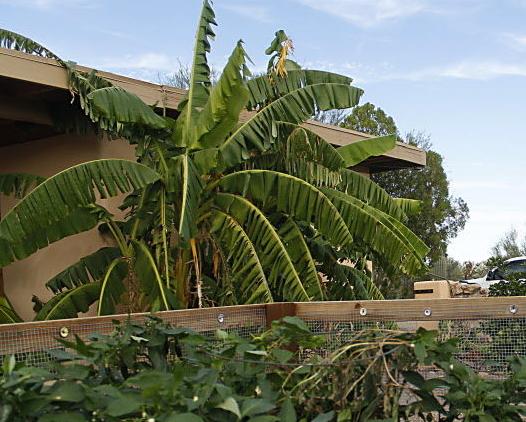Q: About 15-20 years ago my son gave my husband a banana tree that was about 3 feet tall. It sat outside in the hot sun in the summer and in the low 20s in the winter. We live in the Tanque Verde area so we are close to the wash where it does get down to 14 degrees in the winter. The tree languished there until about three years ago.
It was dying, all brown, scaly, and all the leaves were peeling off. I decided that it was either going to die or we had to do something. So we put it into a 3-foot diameter pot with better soil (potting soil mixed with our llama and rabbit poop) and moved it into the “hot tub room.” This is a room with a hot tub and a 15-foot ceiling and windows facing north. So, the banana tree started to grow. Now it is so tall and robust that the leaves are touching the ceiling and it has bananas. I water it about three times a week and it is looking good. My question is, what next?
A: Congratulations on bringing your banana plant back to good health. Bananas in an ideal situation will multiply rapidly and form a grove. Like many plants, they require water, fertilization, and sun. The watering is more critical during the warm months when they are actively growing.
Your well-draining soil and fertilizer are surely helpful as it grows. Our hot desert sun can be too much for young plants, so it is good to protect them. A larger container would allow your plant to grow bigger and spread out. Dividing up the two plants would allow you to keep one inside and put one outside while the weather is warm, if that is appealing.
I’ve seen banana plants in landscapes in Phoenix. There may be some in Tucson, but we are more prone to the occasional frost or freeze and bananas cannot tolerate much cold weather. Keeping it indoors or in a protected area outside is the best we can do here.
Fruiting requires 10 to 15 months of above-freezing temperatures, so keeping it in a greenhouse or in your hot tub room is the best way to grow the fruit. If you plan to keep one outside, be prepared to cover it as we do for citrus and sensitive cacti and succulents if cold temperatures are in the forecast.
Peter L. Warren is the urban horticulture agent for the Pima County Cooperative Extension and the University of Arizona. Email: plwarren@cals. arizona.edu





